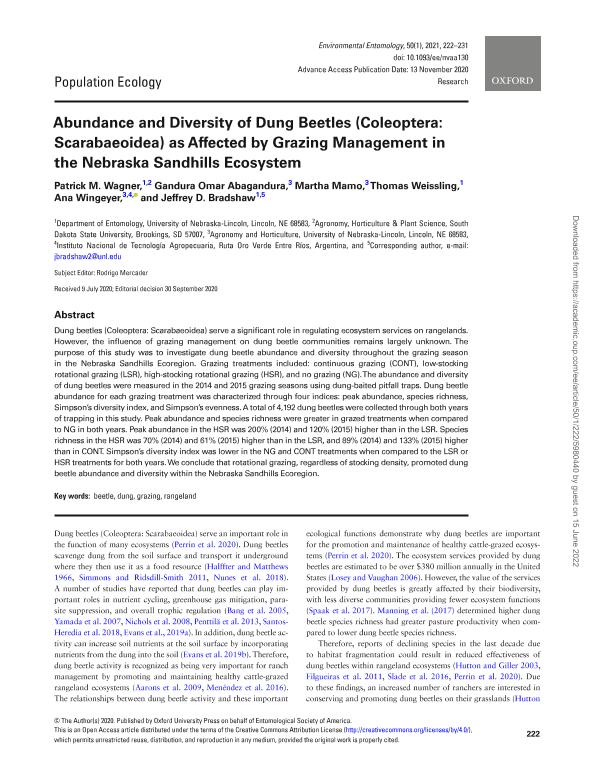Mostrar el registro sencillo del ítem
dc.contributor.author
Wagner, Patrick M.
dc.contributor.author
Abagandura, Gandura Omar
dc.contributor.author
Mamo, Martha
dc.contributor.author
Weissling, Thomas
dc.contributor.author
Wingeyer, Ana Beatriz

dc.contributor.author
Bradshaw, Jeffrey D.
dc.date.available
2022-07-05T12:31:21Z
dc.date.issued
2021-02
dc.identifier.citation
Wagner, Patrick M.; Abagandura, Gandura Omar; Mamo, Martha; Weissling, Thomas; Wingeyer, Ana Beatriz; et al.; Abundance and Diversity of Dung Beetles (Coleoptera: Scarabaeoidea) as Affected by Grazing Management in the Nebraska Sandhills Ecosystem; Entomological Society of America; Environmental Entomology; 50; 1; 2-2021; 222-231
dc.identifier.issn
0046-225X
dc.identifier.uri
http://hdl.handle.net/11336/161269
dc.description.abstract
Dung beetles (Coleoptera: Scarabaeoidea) serve a significant role in regulating ecosystem services on rangelands. However, the influence of grazing management on dung beetle communities remains largely unknown. The purpose of this study was to investigate dung beetle abundance and diversity throughout the grazing season in the Nebraska Sandhills Ecoregion. Grazing treatments included: continuous grazing (CONT), low-stocking rotational grazing (LSR), high-stocking rotational grazing (HSR), and no grazing (NG). The abundance and diversity of dung beetles were measured in the 2014 and 2015 grazing seasons using dung-baited pitfall traps. Dung beetle abundance for each grazing treatment was characterized through four indices: peak abundance, species richness, Simpson's diversity index, and Simpson's evenness. A total of 4,192 dung beetles were collected through both years of trapping in this study. Peak abundance and species richness were greater in grazed treatments when compared to NG in both years. Peak abundance in the HSR was 200% (2014) and 120% (2015) higher than in the LSR. Species richness in the HSR was 70% (2014) and 61% (2015) higher than in the LSR, and 89% (2014) and 133% (2015) higher than in CONT. Simpson's diversity index was lower in the NG and CONT treatments when compared to the LSR or HSR treatments for both years. We conclude that rotational grazing, regardless of stocking density, promoted dung beetle abundance and diversity within the Nebraska Sandhills Ecoregion.
dc.format
application/pdf
dc.language.iso
eng
dc.publisher
Entomological Society of America

dc.rights
info:eu-repo/semantics/openAccess
dc.rights.uri
https://creativecommons.org/licenses/by-nc-sa/2.5/ar/
dc.subject
BEETLE
dc.subject
DUNG
dc.subject
GRAZING
dc.subject
RANGELAND
dc.subject.classification
Otras Ciencias Agrícolas

dc.subject.classification
Otras Ciencias Agrícolas

dc.subject.classification
CIENCIAS AGRÍCOLAS

dc.title
Abundance and Diversity of Dung Beetles (Coleoptera: Scarabaeoidea) as Affected by Grazing Management in the Nebraska Sandhills Ecosystem
dc.type
info:eu-repo/semantics/article
dc.type
info:ar-repo/semantics/artículo
dc.type
info:eu-repo/semantics/publishedVersion
dc.date.updated
2022-06-24T17:21:51Z
dc.journal.volume
50
dc.journal.number
1
dc.journal.pagination
222-231
dc.journal.pais
Estados Unidos

dc.description.fil
Fil: Wagner, Patrick M.. Universidad de Nebraska - Lincoln; Estados Unidos
dc.description.fil
Fil: Abagandura, Gandura Omar. Universidad de Nebraska - Lincoln; Estados Unidos
dc.description.fil
Fil: Mamo, Martha. Universidad de Nebraska - Lincoln; Estados Unidos
dc.description.fil
Fil: Weissling, Thomas. Universidad de Nebraska - Lincoln; Estados Unidos
dc.description.fil
Fil: Wingeyer, Ana Beatriz. Instituto Nacional de Tecnología Agropecuaria. Centro Regional Buenos Aires; Argentina. Universidad de Nebraska - Lincoln; Estados Unidos. Consejo Nacional de Investigaciones Científicas y Técnicas; Argentina
dc.description.fil
Fil: Bradshaw, Jeffrey D.. Universidad de Nebraska - Lincoln; Estados Unidos
dc.journal.title
Environmental Entomology

dc.relation.alternativeid
info:eu-repo/semantics/altIdentifier/doi/http://dx.doi.org/10.1093/ee/nvaa130
dc.relation.alternativeid
info:eu-repo/semantics/altIdentifier/url/https://academic.oup.com/ee/article/50/1/222/5980440
Archivos asociados
